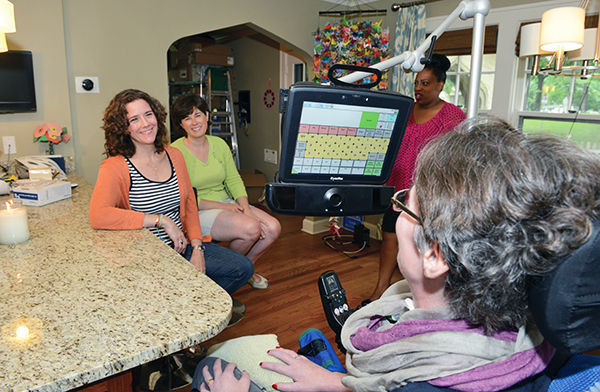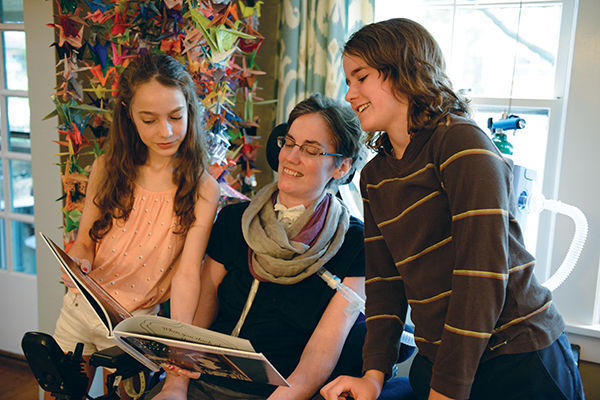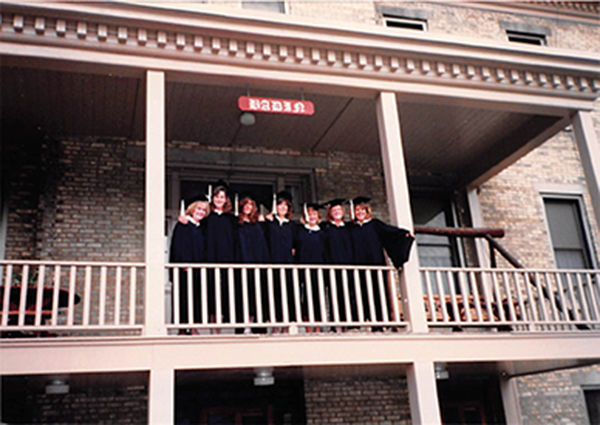Michelle Melland ’88 is propped up in a hospital bed in the master suite off the kitchen of her two-story house in Kansas City, Missouri. Her eyes light up as I walk into the bedroom, and then she dissolves into tears. I maneuver around the bed and medical equipment to give her an awkward hug hello, which she can’t return because of the paralysis throughout her body due to amyotrophic lateral sclerosis, or ALS. Piaget, one of Michelle’s eight caregivers, carefully wipes Michelle’s eyes and dabs at her wet cheeks.
“Hi, Buck!” I use the nickname we gave each other while we were undergraduates at Notre Dame. Neither one of us can remember how we came up with it or why we started using it. We once made a list, while eating dinner in the South Dining Hall, of all of the nicknames we had for our friends, fellow classmates and other people we recognized on campus. Some we didn’t even know, but they were familiar to us from having spent years at the same university, crisscrossing the same quadrangles, eating our meals around the same time. The list grew to about 75 names.

I begin to describe my perilous journey, having flown in from Texas during heavy storms earlier that day. It was the first time that I was making the trip alone, without any of our four other Badin Hall roommates, and I had gotten lost en route from the airport. I unknowingly drove into Kansas, which isn’t difficult to do since her house is within a few blocks of the Missouri-Kansas state line. I am telling Michelle how a salesperson tried to sell me a new car after I stopped at a dealership to ask for directions when a woman’s computerized voice interrupts me. “Hi, Buck!”
Nearly five minutes have passed since I first walked into the room and said hello. It has taken Michelle that long to synch her gaze with the sensitive DynaVox EyeMax screen that hovers above her bed. She has had the system for only a few weeks. Using eye-tracking technology, she is able to choose letters from a keyboard to “type” words, phrases and sentences that are then spoken aloud by the computer.
It has been four months since I last saw Michelle over the Martin Luther King, Jr. holiday weekend. Her voice was weak then, but she could still talk. Now her voice is gone, and she breathes using a ventilator that pings and pumps next to her bed. I knew she had begun using the DynaVox system, so I expected to hear a synthetic voice. But I am surprised that it is female. When I mention this, Michelle wiggles her eyebrows flirtatiously and gives me a big smile.
We spend the next four hours talking. I ask questions, Michelle moves her eyes across the keyboard on the tablet-sized DynaVox screen to painstakingly spell out her responses. Caregivers change shifts, and Paul Melland, her husband of 17 years, comes in and out of the room to check on her. At one point Paul recounts a story about a family vacation to Boston taken a year or so earlier. Michelle was in a wheelchair, flights were delayed and then canceled, and airport personnel were being less than sympathetic. The experience was horrible, but it becomes darkly funny in the retelling. Michelle watches Paul intently, smiling and egging him on with her animated brown eyes.
The late afternoon sun streaming through a bedroom window makes its way across the lightweight blanket covering Michelle’s long legs. It illuminates the plastic tubing that connects the ventilator to her tracheostomy tube, which rests on a small piece of white gauze, called “pants,” that covers her neck incision. The cut and color of the gauze convey an oddly formal air, as if she’s sporting a pristine tuxedo collar.

Michelle is wearing a fashionable, cap-sleeved T-shirt and knee-length yoga pants. I’m reminded of a previous visit with our other roommates, when we went shopping at Hall’s, an upscale Kansas City department store. Margo Kirchner ’88 and Sue Pusek ’88 combed through the shoe sale racks while I stood by Michelle, who was in her wheelchair. “I never know what to buy anymore,” she said as she gestured toward the racks of skimpy summer clothes. I assumed she was talking about dressing for the wheelchair, or for a body slowly losing muscle mass because of ALS. “What’s appropriate for us now?” she wondered. Only then did I realize she was referring to hemlines and the fact that we were entering middle age.
Now it is May, ALS Awareness Month, although neither one of us mentions it during my visit. Michelle, 48, was diagnosed with ALS three years ago, in August 2011. The degenerative neuromuscular disease is also known as Lou Gehrig’s disease, named for the New York Yankees’ first baseman who brought ALS to the public’s attention. This year also marks the 75th anniversary of Gehrig’s abrupt retirement from baseball; on July 4, 1939, Gehrig announced his decision in a stirring speech to a sold-out crowd at Yankee Stadium. He died two years later.
Gehrig’s modern-day counterpart may well be former New Orleans Saints backup safety Steve Gleason. Gleason was diagnosed with the incurable disease in 2011, five years after memorably blocking a punt during a game against the Atlanta Falcons on the first night the Superdome re-opened after Hurricane Katrina. The play led to a touchdown and, ultimately, a Saints win, which became synonymous with the city’s resilience and determination to rebuild post-Katrina.
Following his diagnosis, Gleason and his wife, Michel, created the nonprofit Team Gleason. The foundation’s motto, “No White Flags,” represents Gleason’s refusal to surrender to the ravages of ALS, a disease he describes as “under-funded, under-researched, and largely ignored.” Indeed, ALS is considered an “orphan” disease, one that affects fewer than 200,000 people in the United States. Approximately 5,600 Americans are diagnosed with ALS annually.
Michelle and Paul, an IT specialist at the University of Kansas (KU) Medical Center, have become fans of Gleason and his foundation. Gleason’s mantra, “technology is the cure,” resonates for Michelle. Relying on Paul’s expertise, she has utilized a number of advances, such as the speech-recognition software Dragon, to improve her quality of life since her 2011 diagnosis.
- Living with ALS
- My Good Friend is Leaving
- Adding chapters
Michelle Melland, Steve Gleason, the late Palm Beach Post reporter Susan Spencer-Wendel and others seem to represent a new generation of ALS patients. With the Internet and advancing technology, Michelle, Gleason and others like them are harnessing eye gaze, life support and additional assistive devices as well as platforms such as Facebook and Twitter to both improve their day-to-day lives and also to raise public awareness, solicit research funds and, in some cases, extend their lives beyond the two-to-five-year projection typically given at the time of diagnosis. Spencer-Wendel, who died in June, used only her right thumb to type the 300-plus pages of her memoir, Until I Say Goodbye, on her iPhone.
Noting how a “handful” of patients were continuing on with their lives instead of surrendering to ALS, a newly diagnosed Gleason began to realize the role technology was playing in their survival. As he later wrote in an online column for Sports Illustrated in June 2013, “These people were not fading quickly or quietly.”
News of Michelle’s diagnosis reached our Badin Hall group shortly after Labor Day 2011. “Good ND Friends,” she wrote in an email to me and the four other women who had roomed together. “I’m afraid I have bad news.”
A few weeks earlier, Michelle and Paul had met with Dr. April McVey, the director of the ALS clinic at the University of Kansas Medical Center, for a second opinion about ongoing stiffness in her legs and intermittent muscle twitching in her biceps. McVey, who had served as the neurology consultant to the U.S. Air Force Surgeon General, is a cheerful woman in her late 50s who speaks quickly, listens intently and asks lots of questions. She is so upbeat that when she confirmed Michelle’s ALS diagnosis, Paul initially was confused. McVey’s optimistic demeanor had convinced him that the news would be good.
“Hope is therapeutic,” McVey explains. “I try to go on the positive side. We say the words, ‘We have no cure. This is progressive. You will not live a full life. You could possibly have three to five years.’ But if I can’t save them, what can I do that’s positive? The ALS clinic’s mission is to prolong survival and to improve quality of life. I focus on those two missions.”
Michelle’s early symptoms included muscle cramps that began in her legs and spread to her chest. She noticed a change in her running form and increased leg stiffness beginning in February 2011, six months before her appointment with McVey. In retrospect, she probably had started to experience some muscle twitching as early as the previous fall. “By the time I saw her,” recalls McVey, “she was basically weak just in the legs. It was the very beginning of it.”

A lifelong athlete at nearly 6 feet, Michelle had played volleyball and basketball, and set records as a member of the track team at Immaculata High School in Leavenworth, Kansas. Her high jump and long jump records still stand. A friend and former teammate recently put together a thick scrapbook of newspaper clippings and photographs from those days. Hayley, one of Michelle and Paul’s 11-year-old twin daughters, pored over every page of the book when it arrived at the house.
At Notre Dame, which she attended on an Army ROTC scholarship, Michelle continued to play volleyball. She stayed active after college while serving as a transportation officer in Germany, and throughout graduate school at KU, then while working at H&R Block and into parenthood. Each potential ALS warning sign was relatively easy to attribute to new running shoes or a more intense workout routine. But while Michelle’s muscle cramps and twitching are considered “classic” ALS symptoms, the disease itself is highly variable. “There’s not one pattern for everybody,” says McVey.
Because of its variability, ALS can be a difficult disease to diagnose. “It doesn’t look the same in any patient,” says Dr. Shafeeq Ladha ’96, director of the Gregory W. Fulton ALS and Neuromuscular Disease Center at the Barrow Neurological Institute in Phoenix. “In one person it might start in their hand, in another person it might start in their speech. In another person, it might start in their breathing. Unless you’re experienced with the disease, it’s just not something that rises to the top of your list when you’re seeing someone with complaints like that.”
The similarity of ALS to other neuromuscular diseases, in fact, was the subject of a 2010 report published in the Journal of Neuropathology and Experimental Neurology. In the article, a group of neurologists speculated that even Lou Gehrig may not have had Lou Gehrig’s disease but another motor neuron disease distinguished by two sets of proteins not yet detectable in the late 1930s.
Ladha says he probably treated his first ALS patient as a resident, but it wasn’t until years later that he began to specialize in the disease. “ALS drew my attention in part because of how tragic a disease it is,” says Ladha. “Those patients need a lot of help, and by virtue of that we also form relationships with them that are particularly rewarding. You really see on a day-to-day basis how you can make their lives better and help them through this disease. In some ways I find this is the group of people that I can help the most even though I can’t help them live any longer.”
As with the ALS Association (ALSA) clinic Michelle attends in Kansas City, the Fulton ALS Center at Barrow is a multidisciplinary clinic and a research center combined. Such centers are a kind of one-stop shop for ALS patients. Patients can be seen by a team of doctors and other specialists without leaving the exam room. They also can be assessed for the best wheelchair or speech device, and they can receive a variety of treatments, such as a drug infusion or physical therapy, all in one location.
McVey did not practice in a multidisciplinary facility at the start of her career with the Air Force. “It’s been a drastic change to see how people do and how they handle the disease. People that attend the ALSA clinic live longer than people who don’t,” she says, referring to the results of various studies on the subject. “Granted, they’re in the same boat. It’s the ALS boat. But the way they feel about what’s happening to them is very, very different in the current approach, which includes having them in a clinic where there’s a lot of experience dealing with the disease.”
The research component of these clinics is equally important. Currently no drug can stop ALS. The only drug available to treat the symptoms of ALS is Rilutek (also known as riluzole), which slows the disease’s progression of nerve cell damage by only two to three months. One of the hottest areas of ALS research, as with other diseases, involves biological markers, or biomarkers, which are diagnostic measures that are used to assess whether or not a person has a particular disease. “If you look at any disease we’ve cured, we pretty much understand how that disease comes about. To cure ALS, we probably have to have that answer,” says Ladha. At the University of Kansas ALSA clinic, researchers are working with an outside scientist to determine if a particular type of blood test might be able to detect ALS.
Paul Bohn is the Arthur J. Schmitt Professor of Chemical and Biomolecular Engineering at Notre Dame, and his lab has been investigating the molecular products of oxidative stress, another topic of great interest in ALS research. A cell experiences oxidative stress when it is exposed to more reactive oxygen compounds (such as free radicals) than it can immediately break down. Essential compounds such as proteins and DNA, once oxidized, become damaged. “These reactions lead to molecules that have been implicated as biomarkers in the early stages of a variety of neurodegenerative maladies such as ALS,” says Bohn.
Bohn describes his lab’s work in this particular area as “further upstream” than the more targeted research at several ALSA facilities. But his research has been spurred on by the disease. Mark Shannon, Bohn’s friend and former colleague at the University of Illinois, developed an aggressive case of ALS in late 2010. Within two years, he was dead. “There’s an intellectual curiosity component to this research that I would be lying if I told you it wasn’t a really important part of it,” says Bohn. “But Mark’s illness made quite an impression on me.”
At KU’s ALSA center, McVey is involved with an ongoing study that examines oxidative stress and genetic predisposition. “ALS is a genetic disease. You either have a genetic disease or you have a genetic predisposition, and then there’s an X factor that combines with that to give you the disease. We don’t know what the X factor is, and that’s one of the goals of the study: What is different about the people with ALS that may combine with their genetic predisposition?”
Michelle never took Rilutek, deciding it wasn’t worth the cost given the minimal benefits. She briefly considered marijuana, tried supplements, and focused on raising her cholesterol, which was “fun, but not effective.” Her ALS has advanced to the point that she can no longer participate in a research study, but at the time of her diagnosis, she was an eager candidate.
“Less than half of our patients participate in research,” says McVey. “Michelle certainly did. You have to have people that are willing to be randomized to see if something really works. They think, ‘Well, maybe this isn’t going to help me, but this will help somebody else.’ There’s a lot of altruism in ALS.”
Veterans of the U.S. military, particularly those involved in the 1991 Gulf War, have shown an elevated risk for ALS. After graduating from Notre Dame, Michelle spent four years as an Army transportation officer in Germany as part of her ROTC service commitment.
“We really don’t know why there is an increased risk, but it probably relates to stress, and not just emotional stress but the physical rigors of being in the military,” says Ladha. “Motor neurons are responsible for making our muscles go, and while it’s probably not the cause, it may be the trigger to have increased kinds of stress on those motor neurons.” So while it is unclear if Michelle’s time in the military exposed her to a particular toxin that causes ALS, it may be the case that the stresses she endured could have hastened the onset of the disease. Michelle isn’t much interested in what-ifs these days, although she sometimes fantasizes that in the afterlife she will be handed a sealed envelope that will reveal how she got ALS.
“I might be dead by summer without Veterans Administration benefits because insurance won’t cover the 24/7 care needed when on a ventilator,” she tells me via the DynaVox in May. She has been home for two weeks after undergoing a tracheotomy in March followed by weeks of recovery in a skilled nursing facility. Paul and her team of caregivers, which he has dubbed the “Dream Team,” regularly use a suction machine to clear Michelle’s mouth and throat of excess phlegm after a recent bout with pneumonia. Paul’s six weeks of family medical leave is about to come to an end, and he has been working remotely from home as he readies himself to return to full-time IT work at KU Medical Center.
In her 2011 email to us, Michelle ticked off the resources that would bolster her as her ALS progressed. “Mom is working on getting my soul in shape, and Paul is committed to caring for me, when that time comes, and I trust him implicitly.” These days she admits that maintaining her faith has been tough. The Mellands belong to St. Peter’s, a local Catholic church, and the twins have attended its school for years. When the time came in 2012 to make the house more accessible for Michelle, friends from St. Peter’s rallied to help with everything from demolition and build-out to delivering meals during construction and painting the finished rooms. In those moments, says Michelle, she feels her faith, “experiencing God working through friends, family and parishioners.”
A week before my visit with Michelle, Team Gleason had been in the news with an announcement of a $5 million donation made by New Orleans Saints owner Tom Benson to help support the Team Gleason House for Innovative Living that had been built in New Orleans. Michelle speculates that the slow pace of ALS research may have motivated Gleason to focus his foundation’s efforts on immediate patient care through initiatives like the ALS residence. The apartments are designed to allow people living with ALS to control nearly everything within their environment — computers, lights, doors and so on — using eye-gaze technology.
In addition to its text-to-speech capability, Michelle’s DynaVox tablet (provided by the V.A.) has the potential to allow her to control the television, read an ebook and use Skype to communicate remotely. But in May, she and the Dream Team are still adapting to the technology. Michelle is struggling, physically and mentally. She cries often. “I have too much time on my hands and have to figure out something else to do other than watch HGTV,” she says.

Michelle is worried about her twin daughters, who are on the verge of adolescence. In her initial email to us, she specifically requested that we get to know Hayley and Sydney. “I don’t have much of a bucket list yet,” she wrote in 2011, “but I do know for sure that I want to introduce my daughters to Notre Dame and to all of you.”
In August 2012, the Badin group held a minireunion of sorts, renting a house in Colorado with our families. We all converged on a three-story house that sounded better online than it actually was. We made plans to meet up the following January in Kansas City, where Michelle and Paul took us to some of their favorite places. Michelle’s condition deteriorates with each visit, but we’ve slowly gotten to know her girls.
For a while we took turns mailing them monthly care packages. Then our roommate Cathy (Nonnenkamp) Lindner ’88, the marketing genius, suggested we do an “Extreme Makeover” on both of the girls’ bedrooms last January. They had all but abandoned their rooms to spend more time on the first floor, closer to their mother. With guidance from Michelle, we planned to transform each bedroom into the refuge Hayley and Sydney will one day need. Paul arranged for the rooms to be painted before we arrived. We spent a long weekend cleaning, de-cluttering and shopping. We negotiated with Hayley over how many stuffed animals she could keep and with Sydney over her museum-worthy Lego collection. I passed Michelle in the kitchen as I carried a neglected pet cage out to the backyard to be cleaned. “You owe me big time,” I said over my shoulder. She nodded her head and laughed.
“I miss being a strong mom,” Michelle admits in May, perhaps referring to the times post-diagnosis, in an electric wheelchair and with the help of Dragon software, when she traveled to and from work, coached the girls’ volleyball team, and was still able to take family vacations to places like Devil’s Tower National Monument in Wyoming. When I suggest that choosing to undergo a tracheotomy and live hooked up to a ventilator shows a certain amount of strength, she responds, “Being physically strong has always been such an integral part of who I am that I feel a gap where that part of me used to be.”
Two weeks after my visit, on May 19, Steve Gleason tweets that he will undergo his own tracheotomy that evening. Like Michelle, he will then be reliant on a ventilator. While it will prolong their lives, it will not slow the pace of the disease. Less than two weeks after the procedure, Gleason is back on Twitter. “This sh*t aint easy,” he tweets to his more than 82,000 followers.
In mid-June, Michelle posts a journal entry to the CaringBridge website that Paul started to keep friends and family updated post-tracheotomy. “Life on a ventilator,” she writes, “is better than being dead, in my opinion.” She notes that the majority of ALS patients choose not to go on life support. (Less than 1 percent of McVey’s patients are on a ventilator.) She invites people to visit her at the house, because while her ventilator is portable, an outing, she writes, is “a production.” She lays down some ground rules, instructing visitors not to look horrified when they first see her. “Don’t call me ‘poor baby’ and don’t pet my arm like I’m a dog. Just kidding. Kind of.”
That same day, she also reappears on Facebook. “Hey FB friends,” posts Michelle, a woman who has always preferred her movies to end happily. “I need some book recommendations — nothing creepy, sad or disturbing . . . And I’m not into vampires. Thanks!”
Alison Macor is a freelance writer and the author of Chainsaws, Slackers, and Spy Kids: Thirty Years of Filmmaking in Austin, Texas. She lives in Austin.
